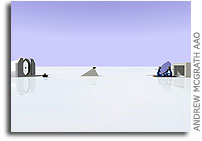Solutions pour Hubble Space Telescop
Alors que nous nous posons des questions de couts et d'utilité pour de faire une mission robotisée pour le Hubble ST qui pourrait s'élever entre 1 milliard et 2.5 milliards de dollar, une solution vient peut-etre de poindre ! En effet, la NASA vient de voir son budget FY05 couper d'1 milliard, et on nous annonce qu'une mission robotisée coutera quasiment le double ! inimaginable ! Voici peut-etre une solution : ''un nouveau telescope en Antarticque avec un mirroir de 16 mètres et qui pourrait laisser loin derrière le HST, peut etre construit pour une somme bien plus désiroire. la source vient de Spaceref.com qui rapporte les paroles de d'un scientifique de l'observatoire anglo-australien à Sydney.
Voila qui fait réfléchir ...
 A novel Antarctic telescope with 16-m diameter mirrors would far outperform the Hubble Space Telescope, and could be built at a tiny fraction of its cost, says a scientist from the Anglo-Australian Observatory in Sydney, Australia.
A novel Antarctic telescope with 16-m diameter mirrors would far outperform the Hubble Space Telescope, and could be built at a tiny fraction of its cost, says a scientist from the Anglo-Australian Observatory in Sydney, Australia.
Tests by a team from the University of New South Wales, reported in the journal Nature this week [16 September], show that the Dome C site in the Australian Antarctic Territory is by far the best place ever tested on Earth for doing infrared and optical astronomy.
"A telescope there would perform as well as a much larger one anywhere else on Earth. It's nearly as good as being in space", said Dr. Will Saunders of the Anglo-Australian Observatory.
At the SPIE Astronomical Telescopes and Instrumentation conference in Glasgow in June, Dr. Saunders presented a concept for an unusual telescope that's well matched to the special conditions at Dome C, both in its optical design and in the way it's built.
It looks nothing like other telescopes. Much of it could be built of icecrete-snow compressed to form blocks as hard as concrete - while its mirrors could be made of the glass used for office windows.
Under the superb atmospheric conditions at Dome C this simple telescope could make razor-sharp images of large areas of sky.
Dr. Saunders estimates that his design would cost about a fifth as much as one of the extremely large telescopes now being planned. These have mirrors 30-100 m in diameter and price tags of US$700 million and up. The Hubble Space Telescope cost a few times more: about US$2.2 billion at launch.
"With this simple telescope you could do the exquisite imaging that the extremely large telescopes plan to do, at a fraction of their cost" Dr. Saunders said. "But, unlike them, this telescope would also be a great survey instrument, able to map the whole sky with Hubble-like clarity."
IMAGES
Available at ftp://ftp.aao.gov.au/pub/local/will/what/
Concept overview Small (25 K) ftp://ftp.aao.gov.au/pub/local/will/what/what-spie-overview_150.jpg
Medium (235 K) ftp://ftp.aao.gov.au/pub/local/will/what/what-overview_horiz.jpg
Large (591 K) ftp://ftp.aao.gov.au/pub/local/will/what/what_overview_horiz3.jpg
On the right is the corrector: a nearly flat, steerable reflector. This receives the light from the sky and directs it onto the primary mirror, over at the left. The primary focuses the light onto a prime focus unit lying halfway between the two mirrors. The prime focus unit could be a number of things: a camera, a device that holds optical fibres for capturing the light, or a secondary mirror reflecting the light through a central hole in the primary mirror. Credit: Andrew McGrath, AAO
Telescope corrector
Small (29 K) ftp://ftp.aao.gov.au/pub/local/will/what/what_corrector_horiz_150.jpg
Large (820 K) ftp://ftp.aao.gov.au/pub/local/will/what/what_corrector_horiz3.jpg This is a nearly flat, steerable reflector. It receives the light from the sky and directs it onto the telescope's primary mirror. Credit: Andrew McGrath, AAO
Animation (17 MB avi file) ftp://ftp.aao.gov.au/pub/local/will/what/what-spie.avi Credit: Andrew McGrath, AAO
REFERENCE
Lawrence J. S., Ashley M. C. B., Tokovinin A. & Travouillon T. Nature, 431. 278 - 281 (2004).



/https%3A%2F%2Fassets.over-blog.com%2Ft%2Fcedistic%2Fcamera.png)
/http%3A%2F%2Fe4sweblog.canalblog.com%2Fimages%2F143942main_ISS_config.jpg)
/http%3A%2F%2Fe4sweblog.canalblog.com%2Fimages%2F18466699.jpg)